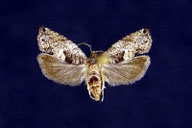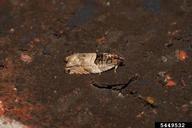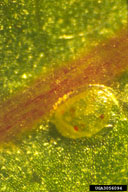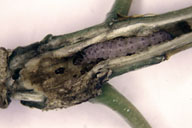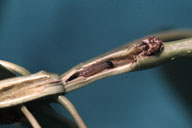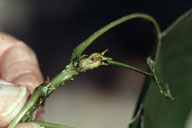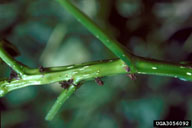Cotton twig borer
Gypsonoma haimbachiana (Kearfott) (Lepidoptera: Tortricidae)
Orientation to pest
Cotton twig borer, Gypsonoma haimbachiana (Kearfott), is a native tortricid found throughout the eastern United States and parts of southern Canada. It bores in the stems of young eastern cottonwood (Populus deltoides Bartr.) and is considered an important pest of young cottonwoods that are grown in plantations. Winter is spent as young larvae that are found on trees in silk-lined shallow pits excavated in healed over borer entrance holes or other depressions on trees. Some older larvae overwinter in hollowed-out buds. In spring, larvae bore into tender new shoots. After pupation and adult emergence, eggs are laid singly or in small groups on the foliage. New larvae of summer generations cover themselves with silk mixed with trash, then bore into the midrib. After a few days, the larvae abandon their midrib galleries and tunnel in shoots to complete their development. In the southern United States, there may be four to five generations per year. Damaged trees are stunted, crooked, and have many limbs, reducing tree value.
Hosts commonly attacked
This borer attacks various poplars, especially eastern cottonwood.
Distribution
Cotton twig borer is found in the eastern United States, west to Texas and in Ontario, Canada. It is common in the southern United States.
Images of cotton twig borer
| Figure 4. Cottonwood twig broken at larval tunnel of cottonwood twig borer | |||
| Figure 1. Adult of the cottonwood twig borer | Figure 2. Egg of cottonwood twig borer | Figure 3. Larvae of cottonwood twig borer | Figure 5. Frass tubes at cottonwood twig borer entrance holes are a sign of this pest's presence |
Important biological control agents related to this pest species
Some natural enemies of have been noted attacking cottonwood twig borer (e.g., those in Steward and Payne (1972) and Steward (1973), cited below. Also, see comments in Van Driesche et al. (1996). However, these have not been studied sufficiently to get a general understanding of their importance or distribution.
Web links for information on cotton twig borer
Articles
- Morris, R. C. 1967. Biology of Gypsonoma haimbachiana (Lepidoptera: Olethreutidae), a twig borer in eastern cottonwood. Annals of the Entomological Society of America 60: 423-427.
- Stewart, J. W. and T. L. Payne. 1972. Parasites and predators of the cottonwood twig borer in Texas. Environmental Entomology 1: 669-670.
- Stewart, J. W. and T. L. Payne. 1975. Seasonal abundance and impact of the cottonwood twig borer on cottonwood trees. Journal of Economic Entomology 68: 599-602.
- Van Driesche, R. G., S. Healy, and R. C. Reardon. 1996. Biological Control of Arthropod Pests of the Northeastern and North Central Forests in the United States: A review and recommendation. FHTET 96-19, December 1996, USDA Forest Service, Morgantown, see: http://www.forestpestbiocontrol.info/fact_sheets/documents/arthropodpestsnortheastern_northcentral.pdf
- McMillin J. D., M. J. Anderson, E. E. Butin, and E. R. Hart. 1998. Phenology and infestation patterns of the cottonwood twig borer (Lepidoptera: Tortricidae) in Iowa. Great Lakes Entomologist 31:181-190.
